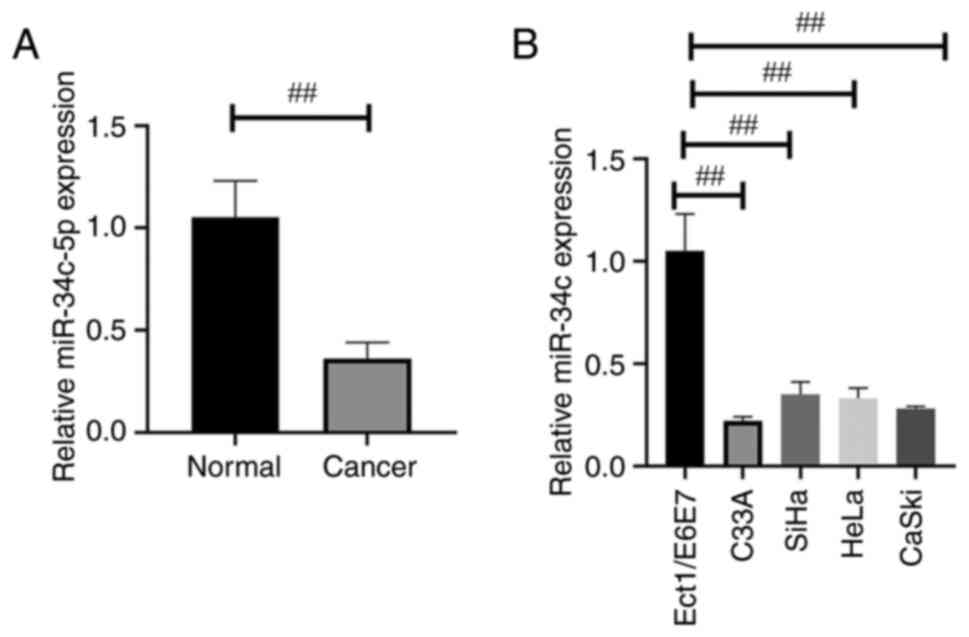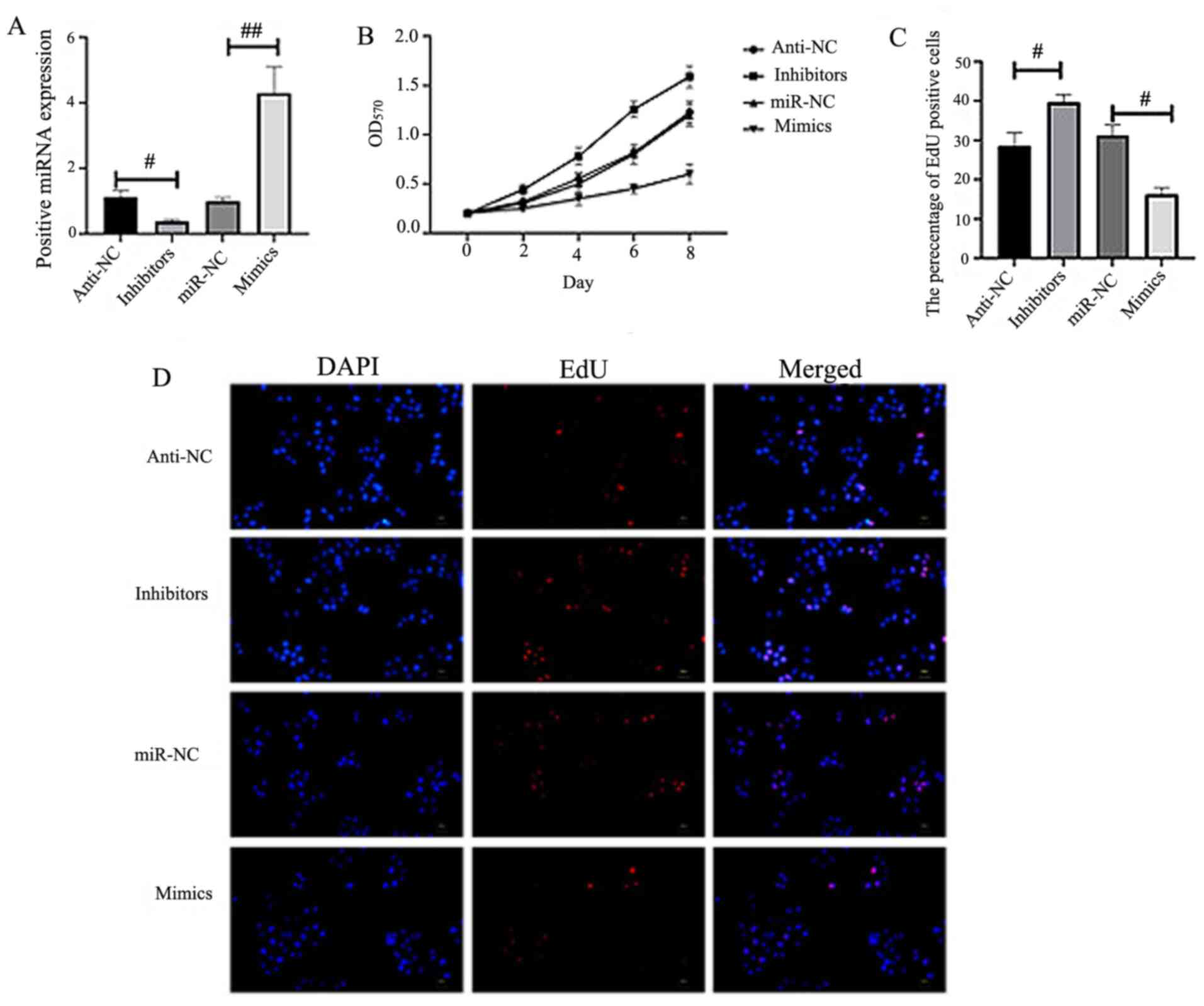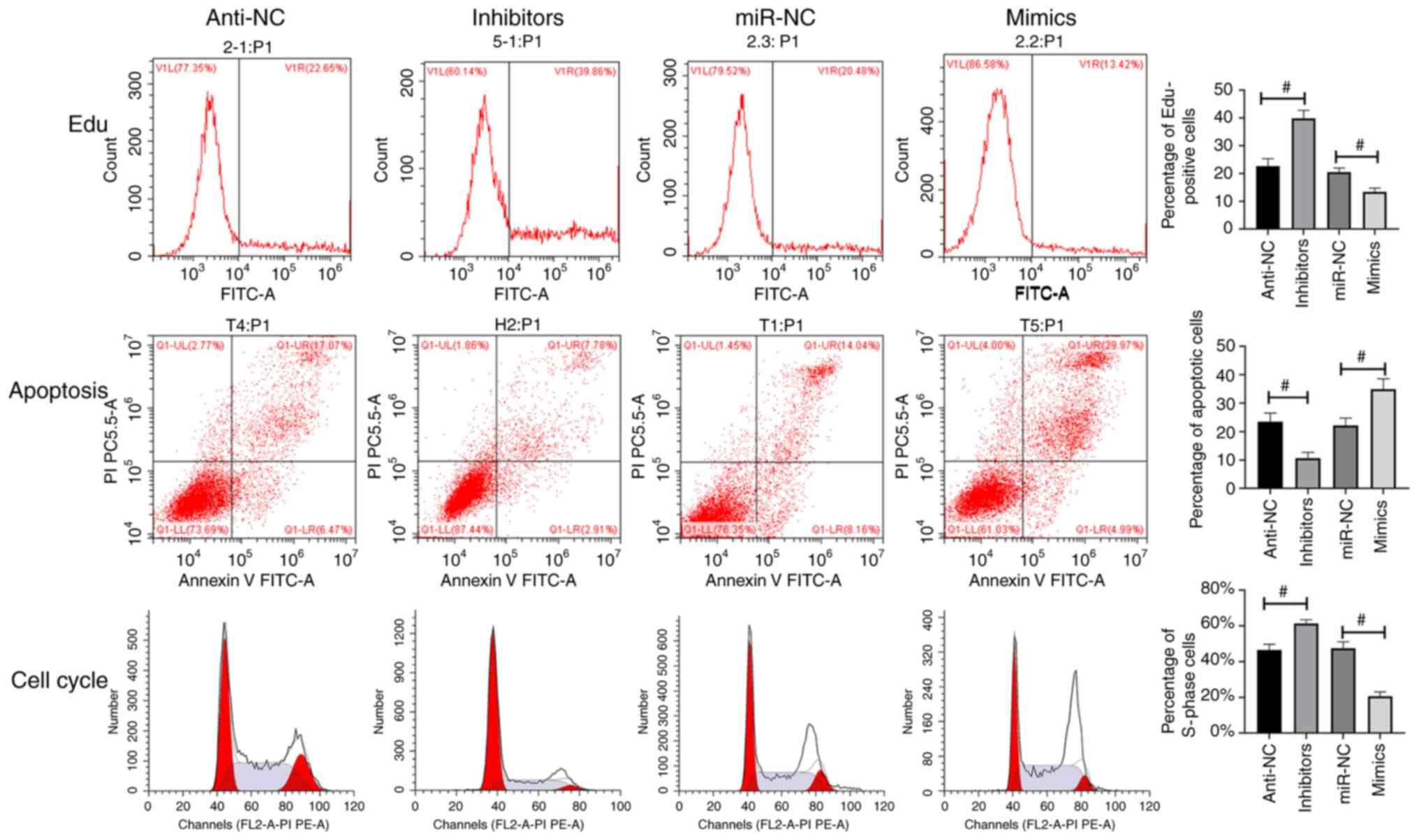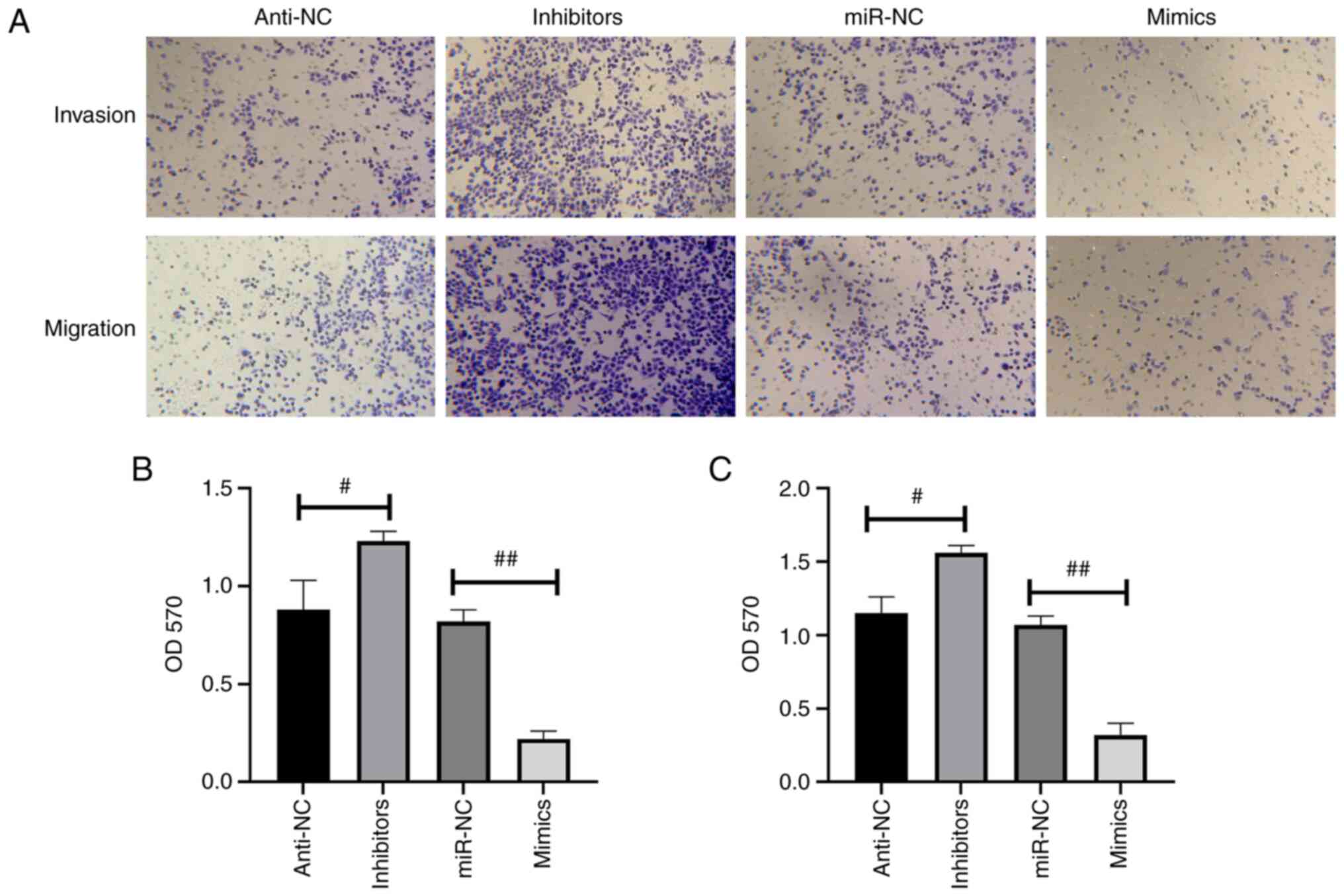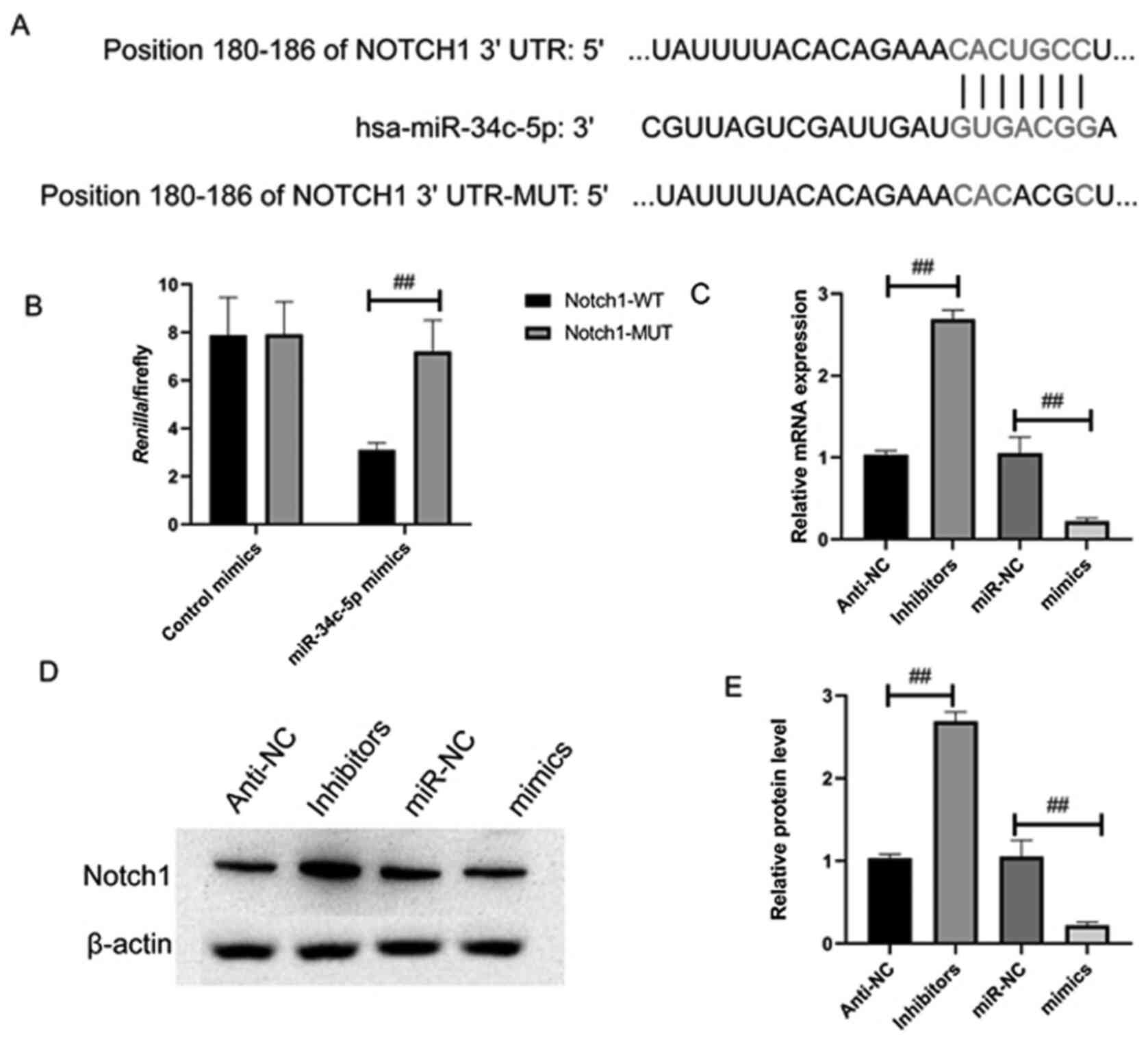miR‑34c‑5p targets Notch1 and suppresses the metastasis and invasion of cervical cancer
- Authors:
- Published online on: December 7, 2020 https://doi.org/10.3892/mmr.2020.11759
- Article Number: 120
-
Copyright: © Wei et al. This is an open access article distributed under the terms of Creative Commons Attribution License.
Abstract
Introduction
Cervical cancer (CC) is known as one of the most common types of gynecological cancers worldwide and it is also the fourth leading cause of female mortality (1). Advances in early diagnosis, surgical resection and chemotherapy/radiation enable patients to receive effective treatments, however, CC prognosis remains poor (2). Causes of death in patients with CC are mainly cancer progression, metastasis and resistance (3). Therefore, investigations into the mechanism and progression of tumorigenesis may provide novel insights for the development of new treatment methods of CC.
MicroRNAs (miRNAs or miRs) are 22nt small non-coding RNA molecules, which are closely implicated in gene expression (4). miRNAs either degrade certain specific genes or inhibit their expression by binding to 3′-untranslated regions (3′-UTRs) of their mRNAs in a complimentary manner (5,6). miRNAs are widely involved in various biological processes including proliferation, tumor metastasis and drug tolerance (7,8). miR-34c-5p has been reported to function as a tumor suppressor in numerous cancer types (9). However, whether the same miRNA serves as an oncogene or not is ultimately dependent on the characteristics of the target genes (10–12). The present study aimed at investigating the effects and mechanism of miR-34c-5p in CC.
The Notch signaling pathway is an evolutionarily conserved signaling pathway that mediates proliferation and differentiation as well as the survival and apoptosis of cells (13). The Notch signaling pathway encompasses Notch transmembrane receptors (Notch1-4) and their ligands (Delta-like 1, 3 and 4 and Jagged 1 and 2) (14). The Notch receptor features a single channel transmembrane protein and consists of an extracellular domain, a transmembrane domain and an intracellular domain. Once the Notch signaling pathway is activated by the ligand-receptor of joint cells, the Notch1 receptor is cleaved by γ-secretase, thereby releasing Notch1 intracellular domain (NICD) from the plasma membrane (15). Subsequently, NICD translocates into the nucleus and then participates in the transcription of other transcription factors to further regulate its downstream genes including members of Hes and Hey families (16). The Notch signaling pathway regulates the growth of numerous tissues and cells in a cellular context-dependent way, which further affects cell specialization, proliferation and apoptosis (16). A dysregulated Notch signaling pathway has been revealed in various types of cancer including CC (17). However, the interaction between miR-34c-5p and Notch1 remains to be elucidated. The present study was designed to explore the biological functions and mechanism of miR-34c-5p on CC at a molecular level, hoping to provide a novel approach to the current treatment of this disease.
Materials and methods
Tissue collection
CC and adjacent tissues were collected from 30 patients aged between 29 and 72 who underwent surgical resections at the Emergency General Hospital (Beijing, China) between December 2017 and December 2019. One of the patients who received anticancer treatment was excluded from the study. All tissues were frozen by liquid nitrogen immediately and stored at −80°C for later use. The experimental protocol was authorized by the Ethics Committee of Emergency General Hospital (approval no. 2017SY1503). Prior written informed consent was obtained from each patient.
Hematoxylin and eosin (H&E) staining
Tissue samples were fixed in 4% formalin for 48 h at room temperature. The tissues were then paraffin-embedded, then cut to 5-µm-thick sections. Slides were subjected to H&E stain according the manufacturer's instructions (Beyotime Institute of Biotechnology).
EdU analysis
An EdU detection kit (cat. no. C10310; Guangzhou RiboBio Co., Ltd.) was used to detect cell proliferation. Briefly, cells were plated in 24-well plates at a density of 5×104 cells/well and treated with 50 µM EdU solution for 4 h at 37°C. The cells were then fixed with 4% paraformaldehyde for 10 min at room temperature and treated with 0.5% Triton X-100 at room temperature for 5 min. The nuclei were labeled with DAPI (Guangzhou RiboBio Co., Ltd.).
Cell culture and transfection
Human CC cell lines (C33A, CaSki, HeLa and SiHa) and human immortalized normal cervical cell line (Ect1/E6E7) were acquired from the American Type Culture Collection (ATCC). 293T cells were purchased from the Cell Bank of Type Culture Collection of the Chinese Academy of Sciences. All cell lines were cultured in DMEM (HyClone; Cytiva) supplemented with 10% FBS (HyClone; Cytiva), 100 U/ml penicillin and 100 µg/ml streptomycin (Beyotime Institute of Biotechnology) in a humidified incubator containing 5% CO2 at 37°C. The miR-34c-5p mimics (5′-AGGCAGUGUAGUUAGCUGAUUGC-3′), miR-34c-5p mimics negative control (5′-ACUACUGAGUGACAGUAGA-3′), miR-34c-5p inhibitors (5′-GCAAUCAGCUAACUACACUGCCU-3′) and miR-34c-5p inhibitors negative control (5′-UUCUCCGAACGUGUCACGUTT-3′) were synthesized by Guangzhou RiboBio, Co., Ltd. Full-length Notch1 from human cDNA library was inserted a pcDNA3.1 vector (Invitrogen; Thermo Fisher Scientific, Inc.). A pcDNA3.1 vector alone (empty plasmid) served as a negative control. Cells were transfected using Lipofectamine® LTX reagent (Invitrogen; Thermo Fisher Scientific, Inc.) according to the manufacturer's instructions. HeLa cells were transfected either with miR-NC (50 nM) or miR-34c-5p mimics (50 nM) and/or pcDNA3.1/Notch1 vector (100 nM) or pcDNA3.1 (100 nM). In addition, CaSki cells were transfected with anti-NC (50 nM) or miR-34c-5p inhibitors (50 nM). Following transfection for 48 h, cells were harvested for subsequent experiments and repeated 4 times.
Cell Counting Kit-8 (CCK-8) assay
HeLa cell viability was detected by CCK-8 assay (Beyotime Institute of Biotechnology). HeLa cells (1×103 cells/well) were cultured in 96-well plates for 0, 24, 48 and 72 h, four times in each time group. At a fixed time, 10 µl of CCK-8 was added into each well and incubated for 3 h. The optical density and 450 nm of each well was determined in quadruplicate using Multiskan MK3 (Thermo Fisher Scientific, Inc.).
Transwell assay
Migration and invasion abilities of cells were determined through Corning Transwell chambers (Corning, Inc.). For the detection of invasion capability, an 8-µm pore size Transwell membrane filter was precoated with 30 µl Matrigel™ (BD Biosciences) at 37°C for 4 h. In the migration and invasion detection, HeLa cells (5×104 cells) were resuspended in 100 µl DMEM without the addition of FBS before being transferred to the upper chamber. A total of 600 µl of DMEM supplemented with 10% FBS was added to the lower chamber. Cells were incubated for 12 h before being fixed with 4% paraformaldehyde for 10 min at room temperature and stained with 0.5% crystal violet at room temperature for 20 min. The number of stained cells randomly selected from six fields were counted with images captured under a light microscope (Olympus Corporation; magnification, ×100) and repeated four times.
Western blotting
Tissue samples and treated cells were lysed by radioimmunoprecipitation assay buffer (Beyotime Institute of Biotechnology). Protein concentrations were determined by BCA Protein Assay kit (Pierce; Thermo Fisher Scientific, Inc.). A quantity of protein extract (30 µg total protein/lane) was resolved via 10% SDS-PAGE and transferred onto PVDF membranes and blocked with 5% dried skimmed milk at room temperature for 1 h. The PVDF membranes were incubated with primary antibody (Notch1; dilution 1:500; cat. no. ab52627; Abcam) and β-actin antibody (dilution 1:1,000; cat. no. ab8227; Abcam) with gentle agitation at 4°C overnight and then treated with secondary antibody (horseradish peroxidase-labeled goat anti-rabbit; dilution 1:1,000; cat. no. ab150077; Abcam) at room temperature for 2 h. β-actin served as a loading control. Protein bands were visualized via an enhanced chemiluminescence system (Beyotime Institute of Biotechnology) and repeated four times. Western blots were quantified by ImageJ software (V 1.46; National Institutes of Health).
RNA extraction and reverse transcription-quantitative (RT-q) PCR
A total of 2 µl RNA (at a concentration of 200 ng/µl) was extracted from 2×106 cells and tissues with TRIzol® reagent (Thermo Fisher Scientific, Inc.). cDNA was synthesized by TaqMan® MicroRNA Reverse Transcription kit (Thermo Fisher Scientific, Inc.) according to the manufacturer's protocols. To quantify miRNA and mRNA, a qPCR assay was performed with iQ™ SYBR® Green Supermix (Bio-Rad Laboratories, Inc.) on the platform of an iCycler iQ™ qPCR detection system (Bio-Rad Laboratories, Inc.). Relative levels of miR-34c-5p and Notch1 were calculated as an inverse log of 2-ΔΔCq and normalized to the reference gene (18), repeated four times. Conditions of the thermocycling were as follows: 95°C for 10 min; followed by 40 cycles at 95°C for 15 sec and 60°C for 1 min; annealed at 55°C for 30 sec; and elongated at 72°C for 3 min. β-actin was considered as an internal reference and employed to analyze the expression of Notch 1 gene. U6 was regarded as an internal control for the detection of miR-34c-5p expression. Primers were as follows: Notch1-forward (F), 5′-GAGGCGTGGCAGACTATGC-3′ and Notch1-reverse (R), 5′-CTTGTACTCCGTCAGCGTGA-3′; miR-34c-5p RT primer, 5′-GTTGGCTCTGGTGCAGGGTCCGAGGTATTCGCACCAGAGCCAACGCAATC; miR-34c-5p-F, 5′-CGGAGGCAGTGTAGTTAGCT-3′ and miR-34c-5p-R, 5′-GTGCAGGGTCCGAGGT-3′; U6 RT primer, 5′-AACGCTTCACGAATTTGCGT-3′; U6-F, 5′-CTCGCTTCGGCAGCACA-3′ and U6-R, 5′-AACGCTTCACGAATTTGCGT-3′; β-actin-F, 5′-CATGTACGTTGCTATCCAGGC-3′ and β-actin-R, 5′-CTCCTTAATGTCACGCACGAT-3′.
Flow cytometry
According to the manufacturer's protocol, estimation of the apoptosis rate was performed with Annexin V-PI detection kit (Beyotime Biotechnology Institute). Cell cycles, proliferation and apoptosis rate of each sample were analyzed by flow cytometry (Cytomics Fc500 MPL Flow Cytometer; Beckman Coulter, Inc.) and repeated four times. All data were analyzed with ModFit LT 3.0 (Verity Software House, Inc.).
Luciferase reporter assay
Wild-type (WT) or mutant (MUT) Notch1-3′UTR with the miR-34c-5p binding site was loaded into psicheck2 vector (Promega Corporation). The 293T cells (1×105 cells/well) were co-transfected with 0.1 mg psiCHECK2-WT Notch1-3′-UTR or 0.1 mg psiCHECK2-MUT Notch1-3′-UTR and 10 nM miR-34c-5p mimics or 10 nM miR-34c-5p inhibitors using Lipofectamine® 2000 (Invitrogen; Thermo Fisher Scientific, Inc.) according to the manufacturer's protocol. Cells were cultured at 37°C for 48 h and then analyzed for luciferase activity according to the manufacturer's protocol (GeneCopoeia, Inc.) and the experiment was repeated four times. Luciferase activity was standardized by comparison with Renilla luciferase activity.
Bioinformatics prediction
Potential target genes of miR-34c-5p were identified by using the online prediction system TargetScan 7.1 (http://www.targetscan.org).
Statistical analysis
Data were presented as the mean ± standard error of the mean. SPSS 13.0 software (SPSS, Inc.) was used for statistical processing. Unpaired Student's t-test or one-way ANOVA was used for data analysis. Assays of significant difference were subjected to Tukey's post hoc test. P<0.05 was considered to indicate a statistically significant difference.
Results
miR-34c-5p expression is downregulated in human CC tissues and related cells
The morphology of CC and adjacent tissues (control group) was observed using H&E staining (Fig. S1). To verify the role of miR-34c-5p in CC, miR-34c-5p expression was initially determined in 30 pairs of CC tissues and adjacent tissues by RT-qPCR, which indicated that the miR-34c-5p expression was significantly reduced in tumor tissues compared with normal tissues (Fig. 1A). The level of miR-34c-5p expression was detected in four types of CC cells (C33A, SiHa, HeLa and CaSki) by RT-qPCR and the results indicated that the expression of miR-34c-5p was significantly decreased in CC cell lines when compared with that in Ect1/E6E7 cells (Fig. 1B).
miR-34c-5p inhibits CC cell proliferation and enhances cell apoptosis
miR-34c-5p was overexpressed or silenced in HeLa cells to ascertain its role in the development of CC (Fig. 2A). CCK-8 (Fig. 2B) and EdU analysis (Fig. 2C-D) indicated that the proliferation of HeLa cells was inhibited in the miR-34c-5p-mimics group, while an increase was revealed in miR-34c-5p-inhibitor-transfected HeLa cells (Fig. 2B-D). Flow cytometry was employed to detect cell proliferation, cell cycle and apoptosis with results revealing that miR-34c-5p mimics inhibited cell proliferation and promoted cell apoptosis (Fig. 3).
miR-34c-5p inhibits the migration and invasion capacities of CC cells
Transwell assays demonstrated that the both the migration and invasion abilities in miR-34c-5p-mimic-transfected HeLa cells were significantly reduced compared with the miR-NC group; however, that of miR-34c-5p-silenced HeLa cells exhibited an increase in migration and invasion abilities (Fig. 4).
Notch1 acts as a target of miR-34c-5p
The underlying mechanism of miR-34c-5p was investigated in CC progression, the potential targets of which were predicted using TargetScan. The results demonstrated that Notch1 mRNA 3′-UTR possesses highly conserved binding sites for miR-34c-5p to bind with (Fig. 5A). Correlations between Notch1 and miR-34c-5p were analyzed through luciferase reporter assay. Luciferase reporter plasmid containing wt/mut 3′-UTR human Notch1 binding site was co-transfected with miR-34c-5p mimics into the 293T cells. miR-34c-5p mimics efficiently reduced the luciferase activity of Notch1 wt 3′-UTR in the 293T cells but no effects were observed in the cells transfected with the mut Notch1 3′-UTR (Fig. 5B). As it was identified as a specific target of miR-34c-5p (Fig. 3B), Notch1was highly expressed in CC (Fig. S2). The results of RT-qPCR and western blot analysis demonstrated that overexpression of miR-34c-5p disabled Notch1 expression in HeLa cells at mRNA and protein levels (Fig. 5C-E) in contrast to the miR-NC cells; the opposite results obtained from miR-34c-5p silencing in HeLa cells further demonstrated Notch 1 to be the target of miR-34c-5p.
Discussion
Previous studies have validated the relationship between cancer progression and dysregulated miRNA expression. Several miRNAs have been demonstrated to serve as either tumor suppressors or oncogenes in the development of CC (19–21). Despite numerous miRNAs acting as tumor suppressors and inhibitors of their target gene expression at a low level, they may also elicit an intense oncogene translation, thereby facilitating the development of tumors (22). Overexpressed oncogenic miRNAs may also result in an inhibitory effect on tumor suppressor genes (23).
miR-34c-5p has been revealed to be downregulated in types of cancer (10–12), although the mechanism in CC remains unclear. The present study revealed that the miR-34c-5p expression exhibited a significant decrease in CC and relevant cell lines, indicating that miR-34c-5p served an essential role in cell proliferation, metastasis and apoptosis of CC. The aforementioned findings suggested that miR-34c-5p overexpression hindered the viability, proliferation, migration and invasion of different types of cancer cells and accelerated apoptosis in vitro.
miRNAs inhibit the expression of specific target genes, resulting in regulation of a variety of biological changes (24). miR-34c-5p is expressed at a low level in gliomas compared with normal brain tissues and normal glial cell lines (12). Overexpression of miR-34c-5p was revealed to inhibit U251 cell proliferation and result in S-phase arrest, G0/G1 reduction and cell apoptosis (12). In gastric cancer, miR-34c-5p was revealed to directly bind to the 3′UTR of the microtubule-associated protein tau (MAPT) and inhibit the expression of MAPT (25). The present study determined that miR-34c-5p directly targeted Notch1 mRNA and downregulated Notch1 expression, thereby inhibiting the progression of CC. Notch1 has also been reported to dissociate from the fused negative inhibitor in the primary cilium and then converts into an activated form and migrates to the nucleus (26,27). Notch1 translocation enhances the expression of downstream target oncogenes including cyclin D1 and homeobox protein NANOG (28,29). Notch1 has been revealed to be highly expressed as an oncogene in various cancers including non-small cell lung, breast, liver and gastric cancer (30–33). The present study confirmed that miR-34c-5p impaired Notch1 expression by directly binding to the 3′-UTR of Notch1 mRNA. It also demonstrated a negative correlation between the level of miR-34c-5p and Notch1 mRNA in CC. In addition, it was observed that the overexpression of Notch1 in CC hindered the effect of miR-34c-5p on cell survival and metastasis. All the aforementioned underpin the hypothesis that Notch1 is the direct target of miR-34c-5p.
In conclusion, the present study demonstrated that miR-34c-5p was significantly downregulated in human CC and related cell lines and that overexpressed miR-34c-5p accelerated cell apoptosis and inhibited proliferation, invasion and migration of CC cells. The present study elucidated the biological traits of miR-34c-5p and Notch1 so as to further study their correlation, which may provide novel approaches for the treatment of CC.
Supplementary Material
Supporting Data
Acknowledgements
Not applicable.
Funding
No funding was received.
Availability of data and materials
The datasets used and/or analyzed during the current study are available from the corresponding author on reasonable request.
Authors' contributions
SW, HW and XW conceived and designed the experiments. HW, RJ, XW, XN and XL conducted all the experiments. SW, HW and XW wrote and revised the manuscript. All authors read and approved the final manuscript.
Ethics approval and consent to participate
The present study was approved by the Ethics Committee of Emergency General Hospital (Beijing, China). Prior written informed consent was obtained from each patient.
Patient consent for publication
Not applicable.
Competing interests
The authors declare that they have no competing interests.
References
|
Liu M, Wang Z, Liu Q, Zhu H and Xu N: Expression of Micro-RNA-492 (MiR-492) in human cervical cancer cell lines is upregulated by transfection with wild-type P53, irradiation, and 5-fluorouracil treatment in vitro. Med Sci Monit. 24:7750–7758. 2018. View Article : Google Scholar : PubMed/NCBI | |
|
Song TT, Xu F and Wang W: Inhibiting ubiquitin conjugating enzyme E2 N by microRNA-590-3p reduced cell growth of cervical carcinoma. Kaohsiung J Med Sci. 36:501–507. 2020. View Article : Google Scholar : PubMed/NCBI | |
|
Wang T, Feng J and Zhang A: miR-584 inhibits cell proliferation, migration and invasion in vitro and enhances the sensitivity to cisplatin in human cervical cancer by negatively targeting GLI1. Exp Ther Med. 19:2059–2066. 2020.PubMed/NCBI | |
|
Jones RA, Franks SE and Moorehead RA: Comparative mRNA and miRNA transcriptome analysis of a mouse model of IGFIR-driven lung cancer. PLoS One. 13:e2069482018. View Article : Google Scholar | |
|
Chen Z, Zhang M, Qiao Y, Yang J and Yin Q: MicroRNA-1297 contributes to the progression of human cervical carcinoma through PTEN. Artif Cells Nanomed Biotechnol. 46:1120–1126. 2018. View Article : Google Scholar : PubMed/NCBI | |
|
Lu HJ, Jin PY, Tang Y, Fan SH, Zhang XF, Wang F, Wu DM, Lu J and Zheng YL: microRNA-136 inhibits proliferation and promotes apoptosis and radiosensitivity of cervical carcinoma through the NF-κB pathway by targeting E2F1. Life Sci. 199:167–178. 2018. View Article : Google Scholar : PubMed/NCBI | |
|
Yin Z and Ren W: MicroRNA-217 acts as a tumor suppressor and correlates with the chemoresistance of cervical carcinoma to cisplatin. Onco Targets Ther. 12:759–771. 2019. View Article : Google Scholar : PubMed/NCBI | |
|
Yu LM, Wang WW, Qi R, Leng TG and Zhang XL: MicroRNA-224 inhibition prevents progression of cervical carcinoma by targeting PTX3. J Cell Biochem. 119:10278–10290. 2018. View Article : Google Scholar : PubMed/NCBI | |
|
Ding W, Xin J, Jiang L, Zhou Q, Wu T, Shi D, Lin B, Li L and Li J: Characterisation of peripheral blood mononuclear cell microRNA in hepatitis B-related acute-on-chronic liver failure. Sci Rep. 5:130982015. View Article : Google Scholar : PubMed/NCBI | |
|
Peng D, Wang H, Li L, Ma X, Chen Y, Zhou H, Luo Y, Xiao Y and Liu L: miR-34c-5p promotes eradication of acute myeloid leukemia stem cells by inducing senescence through selective RAB27B targeting to inhibit exosome shedding. Leukemia. 32:1180–1188. 2018. View Article : Google Scholar : PubMed/NCBI | |
|
Re M, Magliulo G, Gioacchini FM, Bajraktari A, Bertini A, Çeka A, Rubini C, Ferrante L, Procopio AD and Olivieri F: Expression levels and clinical significance of miR-21-5p, miR-let-7a, and miR-34c-5p in laryngeal squamous cell carcinoma. Biomed Res Int. 2017:39212582017. View Article : Google Scholar : PubMed/NCBI | |
|
Wu Z, Wu Y, Tian Y, Sun X, Liu J, Ren H, Liang C, Song L, Hu H, Wang L and Jiao B: Differential effects of miR-34c-3p and miR-34c-5p on the proliferation, apoptosis and invasion of glioma cells. Oncol Lett. 6:1447–1452. 2013. View Article : Google Scholar : PubMed/NCBI | |
|
Zhang JY and Xu ZS: Notch signal pathway and chronic lymphocytic leukemia. Zhongguo Shi Yan Xue Ye Xue Za Zhi. 22:1472–1475. 2014.(In Chinese). PubMed/NCBI | |
|
Yang H, Li Y, Li T, Xu M, Chen Y, Wu C, Dang X and Liu Y: Multifunctional core/shell nanoparticles cross-linked polyetherimide-folic acid as efficient Notch-1 siRNA carrier for targeted killing of breast cancer. Sci Rep. 4:70722014. View Article : Google Scholar : PubMed/NCBI | |
|
Lähdeniemi I, Misiorek JO, Antila CJM, Landor SKJ, Stenvall CGA, Fortelius LE, Bergström LK, Sahlgren C and Toivola DM: Keratins regulate colonic epithelial cell differentiation through the Notch1 signalling pathway. Cell Death Differ. 24:984–996. 2017. View Article : Google Scholar : PubMed/NCBI | |
|
Sharif A, Shaji A, Chammaa M, Pawlik E and Fernandez-Valdivia R: Notch transduction in non-small cell lung cancer. Int J Mol Sci. 21:56912020. View Article : Google Scholar | |
|
Sui C, Zhuang C, Sun D, Yang L, Zhang L and Song L: Notch1 regulates the JNK signaling pathway and increases apoptosis in hepatocellular carcinoma. Oncotarget. 8:45837–45847. 2017. View Article : Google Scholar : PubMed/NCBI | |
|
Livak KJ and Schmittgen TD: Analysis of relative gene expression data using real-time quantitative PCR and the 2(-Delta Delta C(T)) method. Methods. 25:402–408. 2001. View Article : Google Scholar : PubMed/NCBI | |
|
Li Y, Ding Y, Ding N, Zhang H, Lu M, Cui X and Yu X: MicroRNA-625-5p sponges lncRNA MALAT1 to inhibit cervical carcinoma cell growth by suppressing NF-κB signaling. Cell Biochem Biophys. 78:217–225. 2020. View Article : Google Scholar : PubMed/NCBI | |
|
Li B, Wu N, Zhang XJ, Wei ZL and Shang LX: MicroRNA-409 inhibits the proliferative ability of cervical carcinoma cells by regulating AKT. Eur Rev Med Pharmacol Sci. 22:936–942. 2018.PubMed/NCBI | |
|
Ma C, Xu B, Husaiyin S, Wang L, Wusainahong K, Ma J, Zhu K and Niyazi M: MicroRNA-505 predicts prognosis and acts as tumor inhibitor in cervical carcinoma with inverse association with FZD4. Biomed Pharmacother. 92:586–594. 2017. View Article : Google Scholar : PubMed/NCBI | |
|
Wei S, Zhang ZY, Fu SL, Xie JG, Liu XS, Xu YJ, Zhao JP and Xiong WN: Hsa-miR-623 suppresses tumor progression in human lung adenocarcinoma. Cell Death Dis. 8:e28292017. View Article : Google Scholar : PubMed/NCBI | |
|
Huang F, Lin C, Shi YH and Kuerban G: MicroRNA-101 inhibits cell proliferation, invasion, and promotes apoptosis by regulating cyclooxygenase-2 in HeLa cervical carcinoma cells. Asian Pac J Cancer Prev. 14:5915–5920. 2013. View Article : Google Scholar : PubMed/NCBI | |
|
Ham O, Lee CY, Kim R, Lee J, Oh S, Lee MY, Kim J, Hwang KC, Maeng LS and Chang W: Therapeutic potential of differentiated mesenchymal stem cells for treatment of osteoarthritis. Int J Mol Sci. 16:14961–14978. 2015. View Article : Google Scholar : PubMed/NCBI | |
|
Wu H, Huang M, Lu M, Zhu W, Shu Y, Cao P and Liu P: Regulation of microtubule-associated protein tau (MAPT) by miR-34c-5p determines the chemosensitivity of gastric cancer to paclitaxel. Cancer Chemother Pharmacol. 71:1159–1171. 2013. View Article : Google Scholar : PubMed/NCBI | |
|
Grisanti L, Revenkova E, Gordon RE and Iomini C: Primary cilia maintain corneal epithelial homeostasis by regulation of the notch signaling pathway. Development. 143:2160–2171. 2016. View Article : Google Scholar : PubMed/NCBI | |
|
Eberhart C: Multiple cilia suppress tumour formation. Nat Cell Biol. 18:368–369. 2016. View Article : Google Scholar : PubMed/NCBI | |
|
Giannone G, Attademo L, Scotto G, Genta S, Ghisoni E, Tuninetti V, Aglietta M, Pignata S and Valabrega G: Endometrial cancer stem cells: Role, characterization and therapeutic implications. Cancers (Basel). 11:18202019. View Article : Google Scholar | |
|
Shen M, Dong C, Ruan X, Yan W, Cao M, Pizzo D, Wu X, Yang L, Liu L, Ren X and Wang SE: Chemotherapy-induced extracellular vesicle miRNAs promote breast cancer stemness by targeting ONECUT2. Cancer Res. 79:3608–3621. 2019. View Article : Google Scholar : PubMed/NCBI | |
|
Wang S, Cai L, Zhang F, Shang X, Xiao R and Zhou H: Inhibition of EZH2 attenuates sorafenib resistance by targeting NOTCH1 activation-dependent liver cancer stem cells via NOTCH1-related MicroRNAs in hepatocellular carcinoma. Transl Oncol. 13:1007412020. View Article : Google Scholar : PubMed/NCBI | |
|
Lu C, Ren C, Yang T, Sun Y, Qiao P, Wang D, Lv S and Yu Z: A noncanonical role of fructose-1, 6-bisphosphatase 1 is essential for inhibition of Notch1 in breast cancer. Mol Cancer Res. 18:787–796. 2020. View Article : Google Scholar : PubMed/NCBI | |
|
Yang LZ, Lei CC, Zhao YP, Sun HW, Yu QH, Yang EJ and Zhan X: MicroRNA-34c-3p target inhibiting NOTCH1 suppresses chemosensitivity and metastasis of non-small cell lung cancer. J Int Med Res. 48:3000605209048472020.PubMed/NCBI | |
|
Hu J, Yu J, Gan J, Song N, Shi L, Liu J, Zhang Z and Du J: Notch1/2/3/4 are prognostic biomarker and correlated with immune infiltrates in gastric cancer. Aging (Albany NY). 12:2595–2609. 2020. View Article : Google Scholar : PubMed/NCBI |



